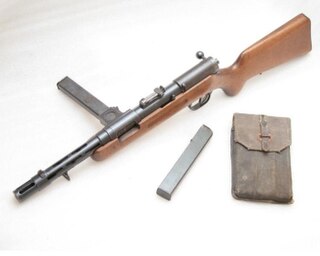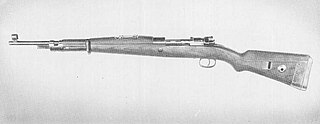
The MP 18 is a German submachine gun designed and manufactured by Bergmann Waffenfabrik. Introduced into service in 1918 by the German Army during World War I, the MP 18 was intended for use by the Sturmtruppen, assault groups specialized in trench combat, as a short-range offensive weapon that would provide individual soldiers with increased firepower over a pistol.

The MP35 was a submachine gun used by the Wehrmacht, Waffen-SS and German police both before and during World War II. It was developed in the early 1930s by Emil Bergmann and manufactured at the Bergmann company in Suhl.
The MP34 is a submachine gun (SMG) that was manufactured by Waffenfabrik Steyr as Steyr-Solothurn S1-100 and used by the Austrian Army and Austrian Gendarmerie and subsequently by units of the German Army and the Waffen SS, in World War II. An exceptionally well-made weapon, it was used by some forces well into the 1970s.
The vz. 24 rifle is a bolt-action carbine designed and produced in Czechoslovakia from 1924 to 1942. It was developed from the German Mauser Gewehr 98 line, and features a similar bolt design. The rifle was designed in Czechoslovakia shortly after World War I, to replace the Vz. 98/22, also a Czech derivative of the Gewehr 98. The vz. 24 featured a 590 mm (23.2 in) barrel which was shorter and considered more manageable than the 740 mm (29.1 in) Gewehr 98 barrel. The vz. 24 was chambered in 7.92×57mm Mauser like its predecessors.

The ZB vz. 26 was a Czechoslovak light machine gun developed in the 1920s, which went on to enter service with several countries. It saw its major use during World War II, and spawned the related ZB vz. 27, vz. 30, and vz. 33. The ZB vz. 26 influenced many other light machine gun designs including the British Bren light machine gun and the Japanese Type 97 heavy tank machine gun. The ZB-26 is famous for its reliability, simple components, quick-change barrel and ease of manufacturing. This light machine gun in the Czechoslovak army was marked as the LK vz. 26. ZB vz. 26 is incorrect nomenclature because "ZB-26" is a factory designation, while "vzor 26" or "vz. 26" is an army designation.

The Madsen is a light machine gun that Julius A. Rasmussen and Theodor Schouboe designed and proposed for adoption by Colonel Vilhelm Herman Oluf Madsen, the Danish Minister of War, and that the Royal Danish Army adopted in 1902. It was the world's first true light machine gun produced in quantity and Madsen was able to sell it in 12 calibres to over 34 countries. The gun saw extensive combat usage for over 100 years, with continued use in limited quantities worldwide into the 2010s. The Madsen was produced by Compagnie Madsen A/S.

The ZB-30 and ZB-30J were Czechoslovakian light machine guns that saw extensive use during World War II.

The puška vz. 33 was a Czechoslovak bolt-action carbine that was based on a Mauser-type action, designed and produced in Československá zbrojovka in Brno during the 1930s in order to replace the obsolete Mannlicher vz. 1895 carbines of the Czechoslovak četnictvo (gendarmerie). The manufacturer's designation was vz. 16/33. Another version, the Vz. 12/33, was also produced for the Latin American market.

The German submachine gun EMP also known as MPE was produced by the Erma factory, and was based on designs acquired from Heinrich Vollmer. The gun was produced from 1931 to 1938 in roughly 10,000 copies and exported to Spain, Mexico, China and Yugoslavia, but also used domestically by the SS. It was produced under license in Spain by the arsenal of A Coruña under the designation M41/44.

The FN Model 1924 series is a line of Mauser Gewehr 98 pattern bolt-action rifles produced by the Belgian Fabrique Nationale. They are similar to the Czech vz. 24 rifle, however have an intermediate length action, featuring open sights, 7.65×53mm, 7×57mm or 8×57mm IS chambering, Long rifle, Short Rifle and carbine-length barrels, hardwood stocks, and straight or curved bolt handles. This pattern rifle was discontinued from production and was no longer offered after 1932 being totally replaced by the 1930 pattern.

The Mauser Model 1889 is a bolt-action rifle of Belgian origin. It became known as the 1889 Belgian Mauser, 1890 Turkish Mauser, and 1891 Argentine Mauser.

The Mauser Model 1895 is a bolt operated magazine fed rifle using the 7×57mm Mauser cartridge. It was exported to many overseas powers, including the Chilean forces which adopted as the Fusil Mauser Chileno Modelo 1895. It is the first major modification of the Mauser Model 1893 and was produced by Deutsche Waffen und Munitionsfabriken, known as DWM, and Ludwig Loewe Company from 1895 to 1900.
The Mauser Model 1904 and Model 1907 were Gewehr 98 pattern bolt-action rifles produced by Mauser and Deutsche Waffen und Munitionsfabriken (DWM). They were designed for export market. Copies were later produced in China and in Spain.
The Standardmodell rifle is a bolt-action rifle designed to chamber the 7.92×57mm Mauser cartridge. The rifle was developed in 1924 but entered full-scale production in 1933. Officially designed for export and German security guards, it was used by the paramilitary Sturmabteilung (SA) and Schutzstaffel (SS). Export variants were used in South America, Ethiopia, China and the Iberian Peninsula. The carbine version of this rifle was almost identical with the Karabiner 98k that became the standard German service rifle during World War II.
The Steyr Model 1912 were Gewehr 98 pattern bolt-action battle rifles produced by Steyr before World War I. They were designed for export market. During the war, they were also used by the Austro-Hungarian Army.










